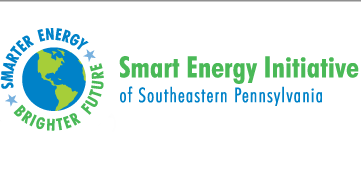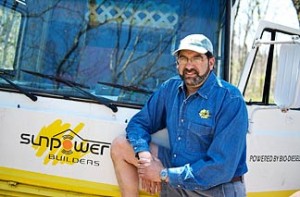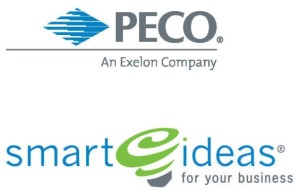Meet Jon Costanza, President of SunPower Builders. As part of our focus on Earth Day this month, we recently sat down with Jon for an exclusive Q&A about his company, his history and his passion.
Jon, for those not familiar with SunPower Builders, briefly talk about your history and what you are doing related to the solar energy and passive house technology?
We are a family run business that’s been in existence for over 40 years now. We are a solar and green building design-build firm for residential and commercial clients. Since we started in 1972 we’ve installed over 100 systems in SE PA; in fact, we’re the largest PA based solar system installers. We are a bit unique and have carved out a niche in the market in that we restore historic structures as well as build newer solar efficiency into all types of structures, new and old. In that regard, we call ourselves the “preservationists of yesteryear and tomorrow.”
That’s a long time to be in what was then an emerging industry. You might be considered to be a visionary. Tell us what prompted you to get involved in this industry?
During the solar “boom” years of the Carter Administration, I installed solar water heating systems. During the Regan administration, the solar “bust” years, I had to switch to high end construction. It was during this time that my interest in historic restorations was piqued. Over time I recognized the similarities between the fields of restoration and solar: both required fine craftsmanship and a deep care for your product, but moreover, there was an essence of practicality and commonsense. It was in this that I discovered a profound common thread . . .We are helping people design and build the beautiful, efficient homes they always dreamed of while helping create a more sustainable future one project at a time.
You have projects that are a unique blend of historic structures merged with newer energy conservation techniques.
Yes. But solar and passive house building techniques really are not new. And many aren’t even technologically advanced. The typical older farmhouse is a passive energy house. Back in the day, builders of these houses did what we now call sustainable building out of necessity. Some examples we see are southfacing structures with over 60% of the glass facing south; overhangs that keep out the summer sun; splayed window sills that throw light back into the building. It was more about common sense practical approaches . . . owners didn’t want to have to chop as much fire wood to warm their homes! Solar design goes way back. Consider the Greeks who built all of their courtyards to be south facing. The difference is that today we have a means of adding solar technology to any type of structure with PV (Photovoltaic) systems and solar panels.
Is it personal for you?
Yes, beyond my passion for my business and the environment, I live in a 1708 farmhouse that is 100% utility free and has been for 20 years. Our house has been on tour for local schools and universities. Too often people think that solar buildings have to look different with pipes and metal sticking out and ruining the aesthetics. Opening my home to tours helps prove that that there’s nothing weird about a solar house.
Can you tell us about some of SunPower Builders’ projects?
We install about 2 megawatts of solar each year within 20 miles of our office in Collegeville, PA. Our projects are small to medium sized residential buildings and also commercial buildings.
We worked with Victory Brewing Company on their building in Downingtown, PA where we installed a solar energy system on the roof. 345 solar panels were installed that provide 82,000 kWh of clean, renewable energy every year. If you visit the restaurant, you’ll see an educational video on the TV in the bar area that we created with Victory to let people know about the carbon offset from their solar system.
We built our first solar house in 1974 in Haverford, PA. At that time people were talking about and concerned about ecology, not global warming; it was a time when the Earth Day movement was getting started. This house was a residence for a professor and we designed an interesting system. The entire roof collected hot air that was then circulated to the basement area with a layer of stone that acted as a heat storage. The heat could then be distributed back through the entire house as needed.
One of our most interesting projects was in the mid 1990’s. We built a solar house in Myerstown, PA for an owner that worked for a pickle company. We designed a hot air collector using over 1,000 glass pickle jars that were filled with water and located in the floor joists. Heat was stored up in the jars and at night was radiated up throughout the house. It’s still in existence and working today!
What’s the biggest challenge of passive house or solar projects?
The misconception about solar is with cost and payback. Contrary to many impressions, solar is affordable. PA has lost or is losing it’s incentives around solar, but today it’s more economical than ever before. Most projects have a 4-7year payback. And with the income stream on a typical residence over a 25 year period you can realize a $100K – $250K profit. That outperforms most retirement plans!
Solar is the only utility system where you can talk about payback; you can’t do that with your heater or air conditioner. Solar pays for itself and generates a cash flow. In brief, once installed, you become an owner of SREC’s (Solar Renewable Energy Certificates) that are a tradeable commodity. Every 1 GW of PV that you generate annually, you earn 1 SREC and those SRECs can be traded on the East Coast Power Grid.
I have a small house Jon, on a small lot, would solar make sense for me?
Well, it depends. Even small houses are candidates. First you need to address reducing loads in the house with more efficient appliances and lighting. That way, if you go solar you can add a much smaller system because your load is reduced. Solar modules can be installed on the roof or in the yard. It’s important to maintain the aesthetics of the house so as not to impact the market value negatively. Solar isn’t “ugly” but I will sometimes tell clients that it won’t work if we can’t make it look right.
In your opinion, can solar continue to have a positive impact on the energy production in this country?
Yes! Consider this: In 2015, 60% of all new electric generation was from solar; that’s more than wind. And Nuclear power plans take 20 years to build. So solar can definitely fill a gap. There is enough sunlight that hits the surface of the US in 1 day to power the country for 1 year. So we have a lot more we can do!
So, what’s next for you and SunPower Builders?
We are strong advocates. In fact, we put our advocacy and belief in solar ahead of profit margins. We are branching out and getting into the development of products and components that aid our first responders in life saving events. We’ve developed a patented product to turn off solar modules on roof tops. This is important because when fire fighters arrive on the scene of a building fire where solar panels are on the roof, there isn’t much they can do because there isn’t any easy way to turn off the system. With our new module this will be possible. We’re hoping soon to partner with businesses in Chester County to bring this device to production. We’re working with SEI and CCEDC on supplier and manufacturing options.
For more about Jon and SunPower Builders visit their website at: http://www.sunpowerbuilders.com/






